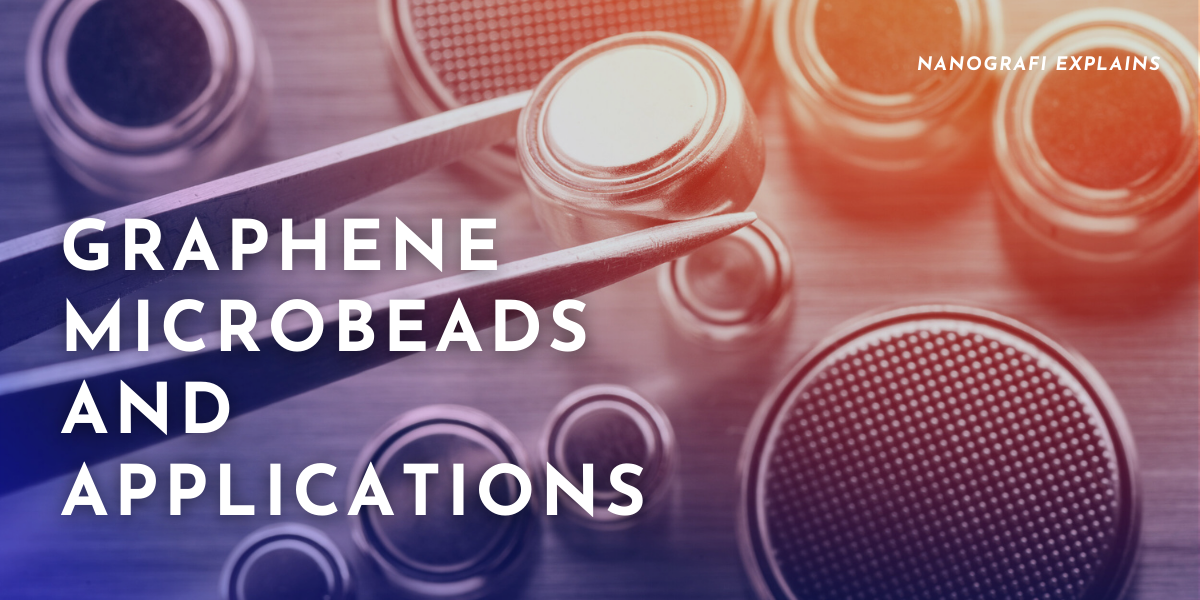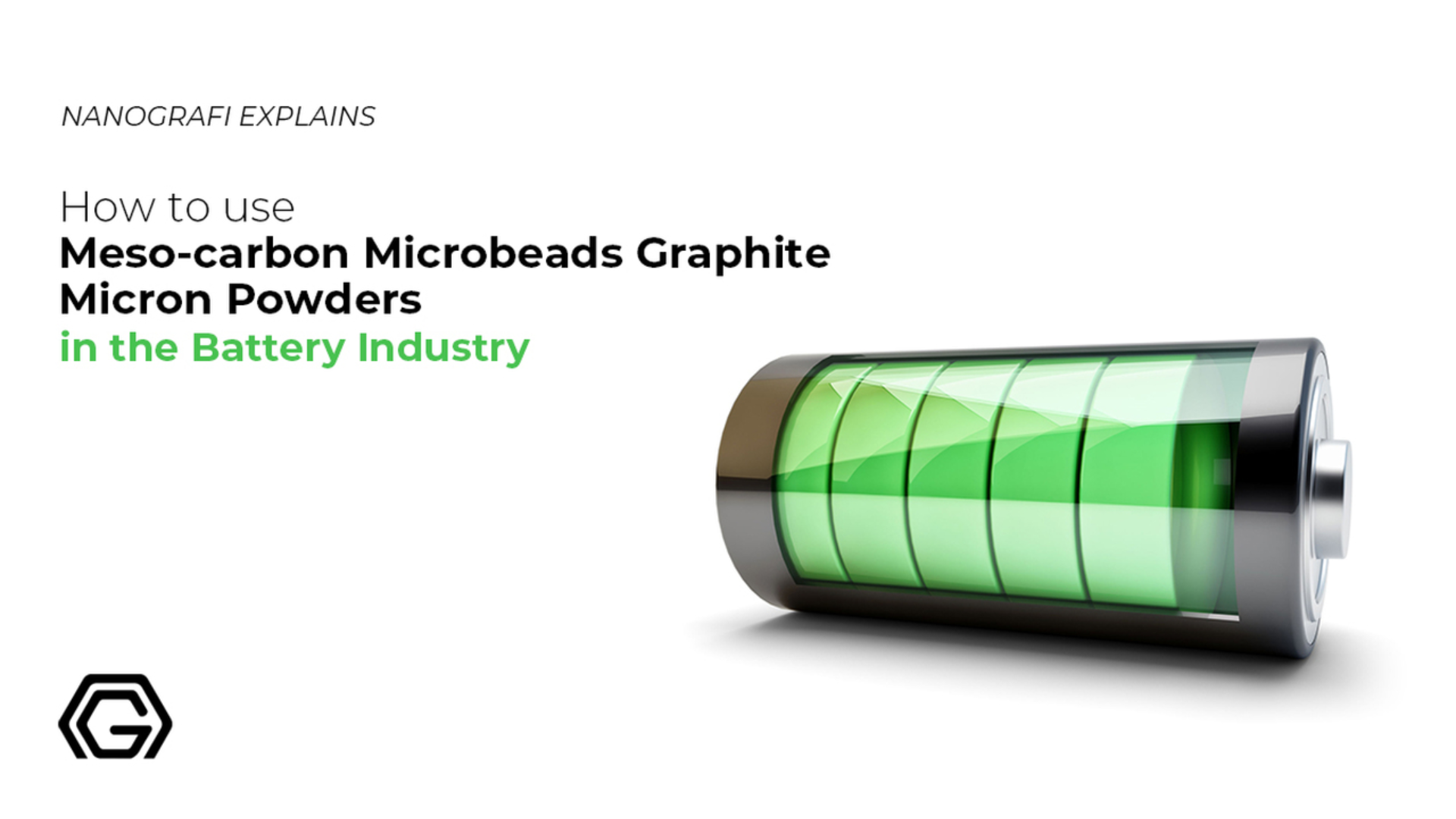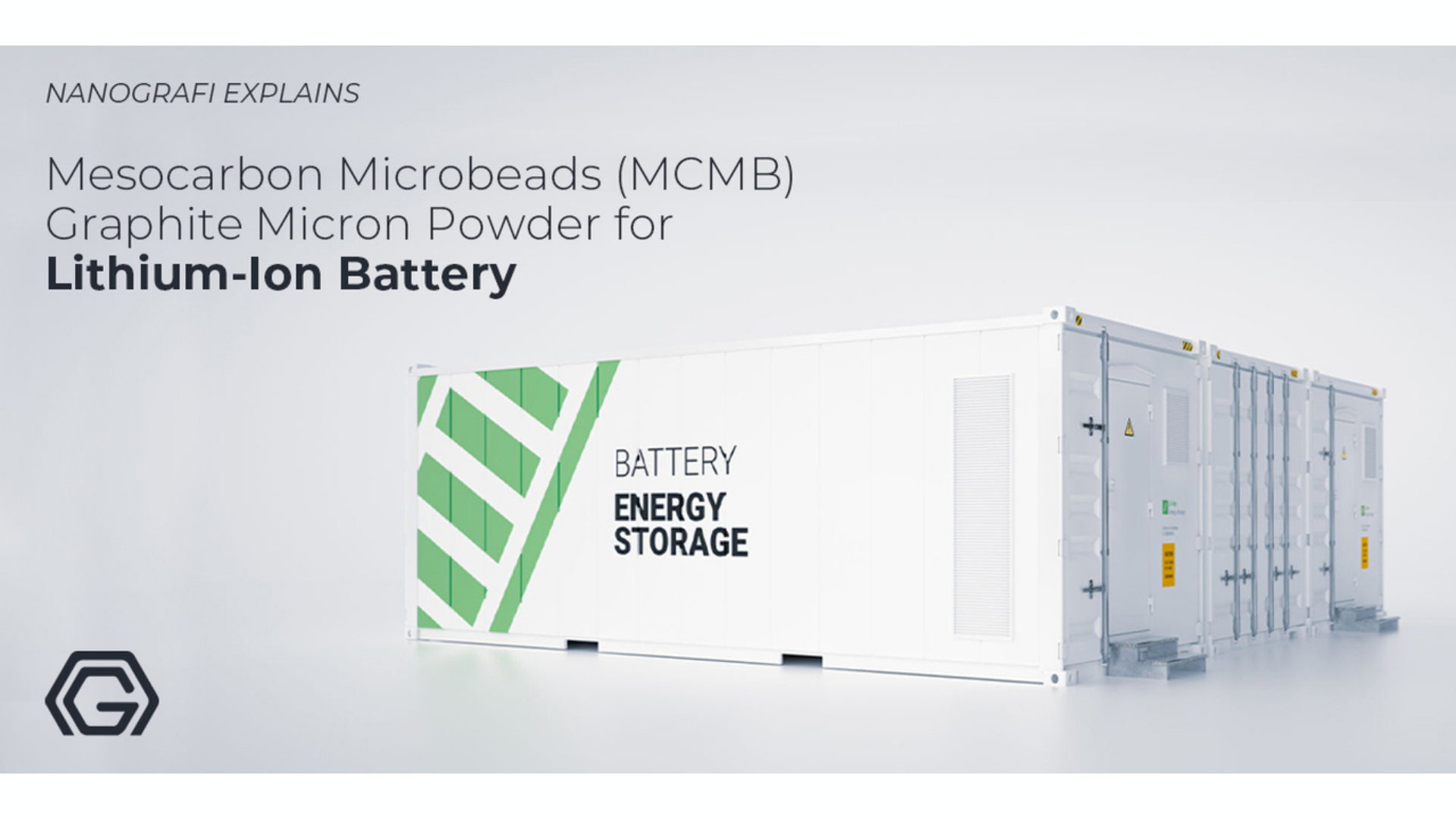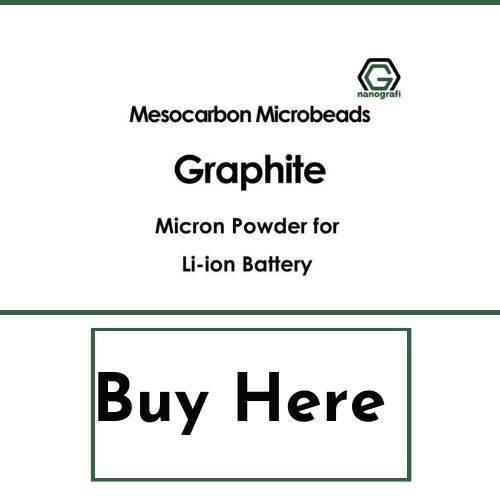Graphene Microbeads and Applications
Graphene is a carbon-related compound having excellent properties and characteristics which enhance up the working mechanics of the products that graphene itself is a part of. When graphene microbeads are formed, they are transformed into another strong compound which benefits the products which are a part of this process.
Introduction
Graphene microbeads' applications and uses are vast and therefore, benefit the industries at a larger scale.The building up of this strong product is not a very smooth process and requires a lot of strenuous work. However, as a result, one of the best products is formed whose benefits are numerous in number.
Supercapacitors have a lot of potential for a broad number of applications in the future as electrical power devices and as a substitute energy system for replacing fossil fuels because of supercapacitor's short charging/discharging time, high power density, and long cycle life. Generally, supercapacitors are classified into pseudo-capacitors or electric double-layer capacitors (EDLCs) due to their mechanism of energy storage. The charges are accumulated in EDLCs at the electrode/electrolyte interface due to ions’ pure electrostatic attraction from the electrolyte, therefore producing an electrochemical double layer.
Critical characteristics are needed by EDLC electrode materials for attaining high performance. Some of those characteristics are (i) remarkable ionic/electronic conductivity for high rate capability, (ii) Suitable pore structure and a small particle size for fast charge/discharge, and (iii) high specific surface areas (SSA) with rich mesopores and micropores for storage of charge.
Carbon-Based Materials
Activated carbon (AC) in particular, and other carbon-based materials are among numerous materials that are best suited to be EDLC electrodes because they possess remarkable properties like low cost, remarkable chemical stability, abundant meso/microporous structure, and high surface area.
Although, these material's poor electrical conductivity and imperfect tortuous pore structure make it more difficult to transport electrolyte ions into interior surfaces or/and micropores at higher scan rates, resulting in their limited rate capability and power density. There have been many efforts on solving these difficulties, like the development of new types of hybrid electrode materials, like graphene/activated carbon, CNTs/activated carbon, and so on are underway.
Electrical Conductivity
For high power electrode materials, CNTs (carbon nanotubes) have been considered as a material of choice because of their readily accessible surface area and remarkable electrical conductivity, however, their usage as a high-performance EDLC is restricted because of the entanglement in CNTs and the limited surface area (∼50–1315 m2 g−1).
Graphene also has a lot of potential as an electrode material as it has remarkable electrical conductivity, and high chemical stability, along with a high theoretical specific surface area (2630 m2 g−1). Due to its low cost for mass production, graphene oxide (GO) is mostly used to make graphene now. Although, because of aggregation, graphene's GO-derived true SSA values are way less than 2630 m2 g−1 as aggregation deteriorates graphene’s electrochemical performance seriously as a supercapacitor electrode material.
However, to increase graphene’s SSA, the effective methods are producing a 3-dimensional highly porous structure and chemical activation. There is still no match of the performance’s improvement with the costs of fabrication.
Activated Mesocarbon Microbeads
One of the AC’s kind is activated mesocarbon microbeads (MCMB), they are cheap, possess a high meso- and microporous fraction, along with a high SSA value of more than 3000 m2 g−1, and have therefore been studied in depth as an EDLC electrode. KOH-activated MCMB’s capacitance behavior was studied by Huang et al. with numerous activation temperatures and mass ratos. He also displayed that the highest specific capacitance (150 F g−1 in 6 M KOH solution at 0.5 A g−1 of current density) is possessed by the sample with 800 C activation temperature and a 4:1 mass ratio of KOH to MCMB.
A simple solution-based oxidative process was used by Wu et al. to make expanded mesocarbon microbeads (EMCMBs) with graphene oxide sheets, and in 1 M KOH solution, EMCMBs’ specific capacitance was 43 F g−1 at 5 A g−1 current density. Meanwhile, Cheng et al. used a simple CVD (chemical vapor deposition) method for making graphitized MCMB (g-MCMB)-based nanostructure hybrids. In Na2SO4 solution, at 0.5 A g−1 current density, the largest specific capacitance of 303 F g−1 was produced by g-MCMB with carbon nanotubes.
In the Presence of KOH Solution
KOH has been used recently for activating MCMB (g-AM) to attain graphene flower-coated activated carbon at high temperatures. It exhibited a pore volume of 1.18 cm3 g−1 and 1855 m2 g−1 of high surface area. This material can be easily prepared as it is a hybrid structure of porous AC and 3-dimensional graphene flowers. Porous graphene flowers as compared to other Graphene-doped AC, possess a stronger resistance towards aggregation and therefore can offer short paths and stable ion transfer pathways for diffusion of ions.
AC's power density and rate capability can be enhanced by graphene due to its comparatively high electrical conductivity. The same is the case with the bridging of AC particles. Some oxygen-containing functional groups are possessed by the Graphene flower's surface, providing it with a remarkable electrochemical performance during the process of charge-discharge.
As a Facile
Thus, the material of this kind with a hybrid structure is what's needed for being utilized as a cheap, facile, and high-performance EDLC electrode. Here, there are investigations regarding the influence of ball milling treatment, time, and activation temperature on g-AM's electrochemical performance, and it was subsequently investigated in a three-electrode system in a 6 M KOH solution. In lithium-based organic electrolyte's two-electrode symmetrical cell, there were further evaluations of the power density and energy for exploring the application potential.
Influences of the time and activation temperature on the activated g-AM.
There were investigations on the influences of time and activation temperature on the electrochemical performance. There have been SEM images of the activated MCMB at various times (0 and 1 hour) and activation temperatures (800-1000 °C). Despite no formation of graphene (AM0b1h-800), several sub-micron spheres were noticed on the spheres when activated for 1 hour at 800 °C. When the time was lessened to 0 hours and temperature was increased to 1000 °C, they observed the sub-micron spheres clearly, and there was the appearance of graphene in a certain amount on the surface.
At 1000 C of fixed temperature, and prolonging of the activation time from 0-1 hour, the sub-micron spheres stopped appearing, and there was graphene formed on the activated carbon's surface in large amounts (when activation times were 1, 0.5, and 0 hours, the samples were named g-AM0b1h-1000, g-AM0b0.5h-1000, and g-AM0b0h-1000).
In Relation to the Porous Electrode’s Microstructure
The porous electrode's microstructure is related closely to its electrochemical performance. There were recordings of samples' Raman spectra activated at several activation times at 1000 °C. Three Raman bonds of 2700 cm−1, 1580 cm-1, and 1350 cm-1 were displayed by all of the samples, corresponding to the 2D, G, and D bands.
For 1, 0.5, and 0 hours of activation times, 0.41, 0.16, and 0.33 was the activated MCMB's D/G peak intensity ratios (ID/IG), revealing that the graphene is at its best quality when 0.5 hour is the activation time, and the defects increased in number under KOH etching when the time was more than 0.5 hour. There was a shift of 2-dimensional peak to a lower wavenumber value, which indicates that with activation time, the number of layers was lessened, and it was contrary to the TEM results.
Nitrogen Isotherms
There have been presentations of nitrogen adsorption-desorption isotherms and MCMB's pore size distributions activated at 1000 °C for numerous times (1, 0.5, and 0 h). In samples, meso- and micropores are seen to coexist. The contents of meso- and micropore went lower when they were activated for 1 hour as compared to the other 2 samples that were having shorter times of activation.
For 1, 0.5, and 0 hours of activation times, 2.55, 3.0, and 2.46 nm are the average diameters whereas 1855, 2436, and 2720 m2 g-1 were the BET-specific surface areas. XPS and Raman's spectroscopies previously characterized MCMB's structure activated for 1 hour at 800 C in the last study. According to the results, when 2.13 nm was the average diameter and 2122 m2 g−1 was the specific surface area, then more microporous content was possessed by carbon.
Different Activation Temperatures
GCD and CV curves were recorded to investigate g-AM's electrochemical performances at different activation times and temperatures. The same GCD and CV behavior was revealed by the materials activated at different times and temperatures. The better electrochemical performance was expected by the MCMB that was activated at 1000 C for 1 hour due to graphene's existence but the results were not as expected, unfortunately.
On the calculation of galvanostatic profiles' discharge curves, at 0.1 A g−1, 265, 241, and 225 F g-1 are the specific capacitances whereas at 1 A g-1, 221, 168, and 169 F g−1 are the specific capacitances when for 1, 0.5, and 0 hours, the samples were activated at 800 °C, which presents an increasing trend with time.
Different Capacitances
However, when they are activated at 1000 C, a decreasing trend with time is shown as at 0.1 A g-1, 110, 147, and 178 F g-1 are the specific capacitances and at 1 A g-1, 100, 128, and 142 F g−1 are the specific capacitances for activation times of 1, 0.5, and 0 hours. It should be noted that on increasing the time of activation at 1000 C and increasing current density from 0.1-1 A g-1, 90%, 87%, and 80% are the retention of the specific capacitances, meaning that activated MCMB’s rate capacity was enhanced because of graphene’s existence in comparison withAM0b1h-800 (less than 83%). It was considered that g-AM-1000 higher rate capability is related to its electrical conductivity.
To get more information about meso-carbon microbeads,
you can read our blog post here.
Results
Samples that were activated at 1000 degrees Celsius had the electrical conductivity that was way more than the electrical conductivity of those samples that were activated at 800 degrees celsius, and with the increase in the activation time, the value also increased. The reason for this is graphene's content which increased with the activation time at 1000 °C, however, for 0.5 hours of activation time, the quality was best.
Influence of Ball Milling on the Activated g-AM
Like we already know, nanospheres and submicron makes up green MCMB which are also seen on MCMB's surface and contained carbon layers of a high order. Therefore, more graphene can be obtained by using ball milling to expose the inner units if graphene was from highly ordered carbon layers. Also, MCMB was made smaller through ball milling treatment to help in iron transport along with the production of a larger specific surface area. Thus, in conclusion, before activation, MCMB was ball milled a lot of times, and there were investigations on the electrochemical performance and microstructure. When the time of ball milling was short, there was no change in graphene's amount on the activated g-AM.
Prolonged Time
However, graphene disappeared gradually when ball milling time was prolonged to more than 6 h. When the time of ball milling increased, it also increased the degree of disorder which made it tough to produce graphene however more contact surface with KOH made chemically itching to the MCMB easier, therefore leading to a decreased activation yield.
Heteroatom Doping
According to the literature, carbon material’s overall specific capacitance can be significantly improved by heteroatom doping by enhancing the active surface area’s accessibility to the electrolyte solution and by enhancing the surface wettability. There were recordings of activated g-AM’s XPS spectra for 24 hours of ball milling time for detecting the inner part’s heteroatom state that is attained after ball milling. Similar patterns were shown in the peaks of both of the samples, those which did undergo any ball milling treatment and those which didn’t too.
Relative Peak Areas
Relative peak areas were used to measure the relative content of the sample’s surface groups. As compared to the content of the oxygen-containing group on the surface, the inner of g-AM had less content of the oxygen-containing group.
Testing of Ball-milling
There were tests of g-AM’s corresponding curves of pore size distribution and nitrogen adsorption-desorption isotherms at various ball milling times. When the ball milling time increased, there was also an increase in the uptake adsorption at low relative pressure P/P0 less than 0.1. Not only there was an increase in the relative pressure, but there was also a slow increase in mesopore range in the adsorption capacity. At more than 0.5 pressure, a significant increase in N2 adsorption capacity was shown by the activated g-AM samples with an increase in the ball milling time, which suggests the increases in the number of mesopores and the pore volume.
Result of the Ball Milling
There is a listing of the data on the structures of pore for KOH-activated g-AM at various milling times in the summary. There were observations of a general increase in the average pore size, pore-volume, and surface area of BET for those samples that underwent ball milling for a prolonged time. All of this was possible because of the lessened particle size of MCMB due to the ball milling method, and therefore the increased surface of contact between MCMB and KOH, affecting the structure of the pore.
To get more information about mesocarbon microbeads,
you can read our blog post here.
Applications of Graphene Microbeads
Mesocarbon Microbeads (MCMB) Graphite Micron Powder for Lithium-Ion Battery
Petroleum residua-derived Mesocarbon microbeads (MCMB) are treated with heat under various experimental conditions. Such MCMBs were characterized by electron paramagnetic resonance (EPR), Fourier transformed infrared spectroscopy (FTIR), proton magnetic resonance (PMR), electron diffraction, and X-ray. After heating under vacuum to 750 C, one can retain two different hydrogen forms. However, graphite ribbon-like particles surrounding microbeads of a size of few microns are a result of graphitization to 3000 C. EPR observed the crystalline graphite monodomains as semi metallic or that they possess a small bandgap.
The localized paramagnetic defects in the microbeads can't be eliminated even at the high treatment of 3000 C. These characteristics condition these material's aptitude towards their usage in sodium and lithium electrochemical cells. Reversible intercalation behavior is possessed by the samples made at 750C, whereas samples made at 30008C evidence solvent decomposition lead to a non-reversible extended discharge plateau when utilizing sodium perchlorate electrolyte dissolved in pure propylene carbonate.
Use of Carbon-Based Intercalation Compounds
Usage of the carbon-based intercalation compounds for Li-ion cell’s negative electrode expands to carbon’s numerous artificial and natural forms and different allotropes. From the structural point of view, graphitized solid, turbostratic material, and unorganized carbon are the three classifications of graphite-related carbons.
There is a notable difference in lithium intercalation's capacity in each of these forms. Hard and Soft carbons are the classification of the less organized forms and it depends on its facility to transform into graphite and at above 2000 C, they transform into the graphitic carbon, whereas even when heat-treated at 2800 C, hard carbon doesn’t show graphitization’s characteristic signs. Soft carbons are most of the cokes and mesocarbon microbeads (MCMB).
Petroleum Coke
Petroleum coke is the most utilized form of soft graphitizable carbons despite being a part of the first commercial lithium-ion cell. In comparison to using other graphitizable forms as active material, if you use coke as an active material then the performance of the intercalation electrode is typically limited.
Properties of MCMB
There were reports on the 6 electrochemical performance of MCMBs' evolution with thermal treatment's temperature, along with the observations of behavior that is similar to the other soft carbons. At Ca. 2000 C, a decrease in capacity was observed to a minimum from the highest value at 7008C, and a progressive increase follows it.Promising behavior is displayed by MCMB regarding its characteristics as it consists of low specific surface area and 1-40 mm (diameter) of roughly spherical structures (microbeads), meaning a high packing density which during Li-ion cells charge-discharge processes can ignore the prolonged side reactions with the electrolyte. Due to this, the observed capacity can reach the value of 750 mAh/g which is double the graphite's theoretical value (for LiC, it is 372 mAh/g).
Lithium-Ion Batteries
In recent years, a lot of research and interest has been gained by lithium-ion batteries because of their excellent characteristics like environmental-friendly, long cycle lives, and high energy densities. For electronic products like computers, laptops, and cellular phones, the most significant power source is lithium-ion batteries. Generally, carbon materials are utilized in Lithium-ion batteries as anode materials due to the stability of their structure during cycling, their small surface change, and their high energy density.
Use of Mesocarbon Microbeads in Batteries
Mesocarbon microbeads are one of the carbon materials that is utilized as the anode material in Lithium-ion batteries. For lithium-ion batteries, mesocarbon microbeads (MCMB) graphite micron powder are carbonaceous materials of a special kind. Generally, Mesocarbon microbeads have a spherical shape with 1-50 µm in diameter. Mesocarbon microbeads can provide remarkable cyclability and 300-340 mAh/g of reversible capacity when they are utilized in lithium-ion batteries as the anode materials both of which are significant advantages for the applications in which high capacity and cyclability is the requirement.
Combination with Silicon
Mesocarbon microbeads have many advantages, one of them being their capability to be in combination with silicon for having higher rechargeability and higher capacities. As compared to all of the types of carbon anode materials, the best cyclability is possessed by mesocarbon microbeads anode materials. Silicon-mesocarbon microbeads of satisfactory rechargeability and high capacity can be obtained when we combine mesocarbon microbeads with silicon for attaining an anode material. So, using the silicon - mesocarbon microbeads composite anode material for extending the number of lithium-ion batteries' charge cycle is possible.
Conclusion
Graphene Microbeads for Lithium-Ion Battery is a very renewed way of making lithium-ion batteries beneficent and useful in their respective field of science. They are excessively used in portable electronics and are paving a new way to success for the electronics and the consumers of those very electronics. The working mechanisms to broaden their essentiality are in continuous progress enhancing the efficacy of graphene microbeads in various respective manners.
To get more information, you can visit Blografi.
References
https://cutt.ly/bJ9PJNT
https://pubs.rsc.org/en/content/articlehtml/2019/ra/c8ra09382b
https://pubs.rsc.org/en/content/articlelanding/2020/dt/c9dt04605d#!divAbstract
https://www.sciencedirect.com/science/article/abs/pii/S1385894714002083
https://www.researchgate.net/publication/339215906_Graphene_Oxide_Nanocomposite_Magnetic_Microbeads_for_the_Remediation_of_Positively_Charged_Aromatic_Compounds
Recent Posts
-
Nanocomposites in Food Packaging
The utilization of nanocomposites in food packaging represents a significant advancement in the fiel …19th Apr 2024 -
What is the Difference Between 7075 and 6061 Aluminum Alloy?
When comparing 7075 aluminum alloy to 6061 aluminum alloy, it's essential to understand their disti …5th Apr 2024 -
Iron-Air Batteries: The Ultimate Guide
Iron-air batteries represent a significant breakthrough in energy storage technology, offering a sus …29th Mar 2024








